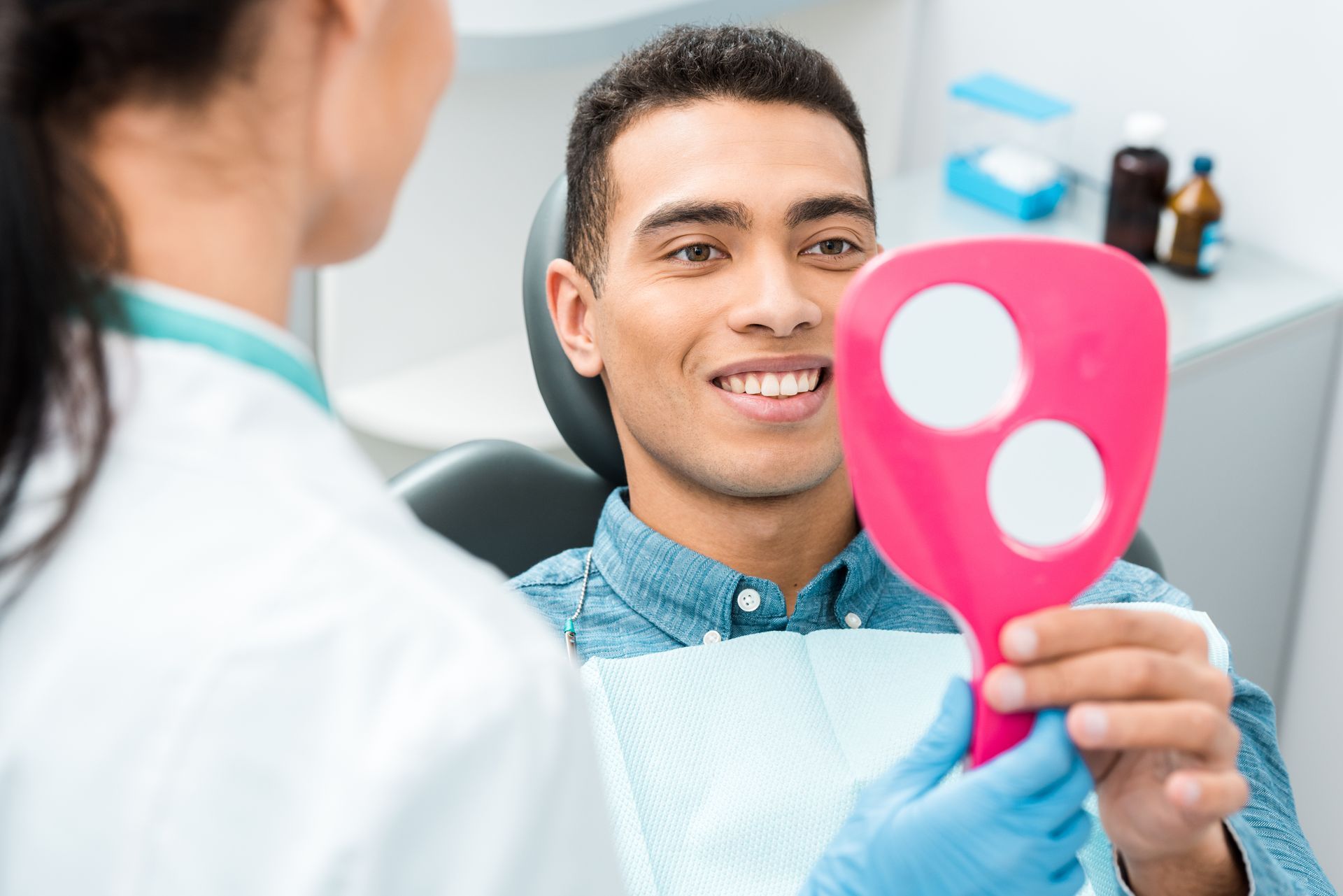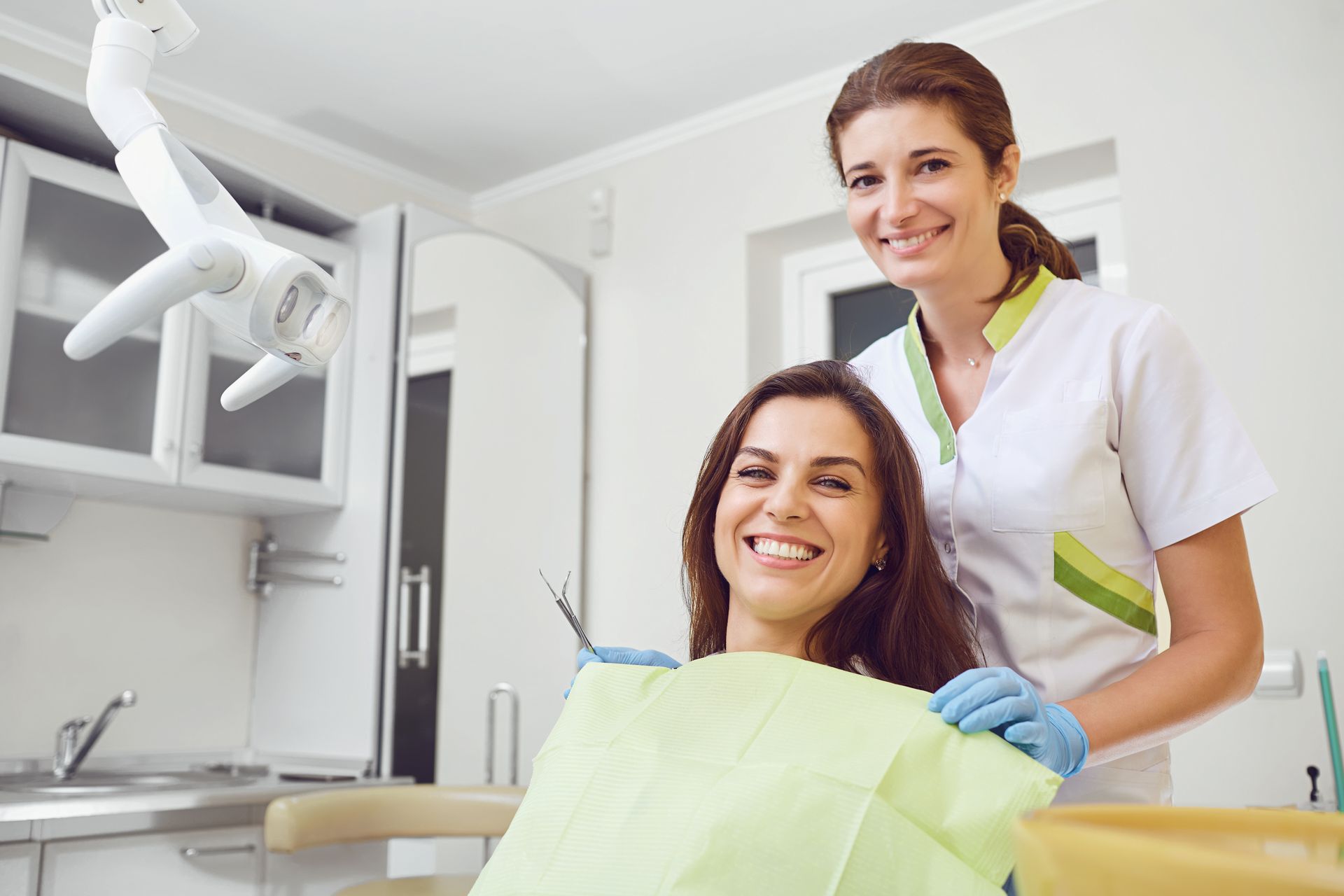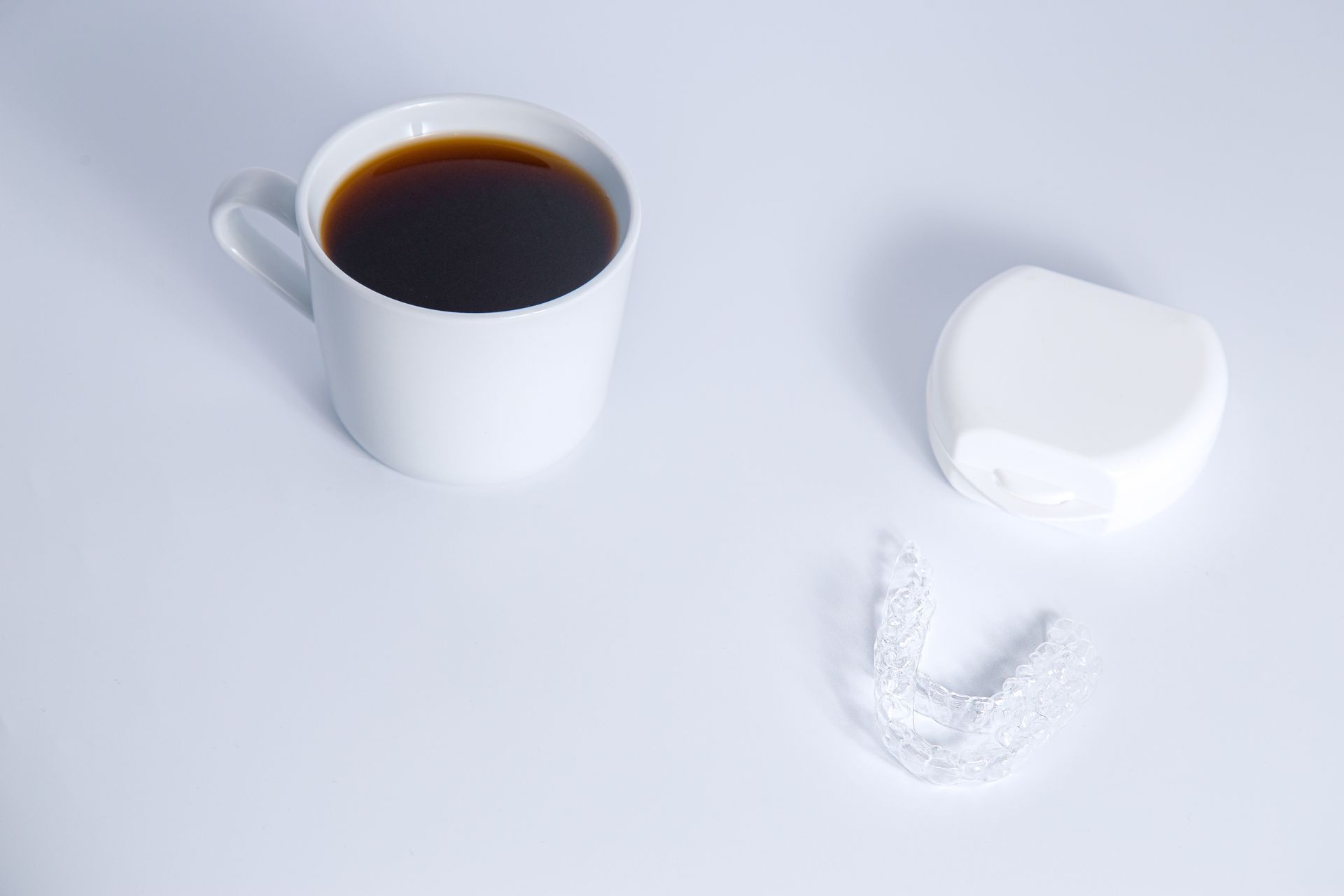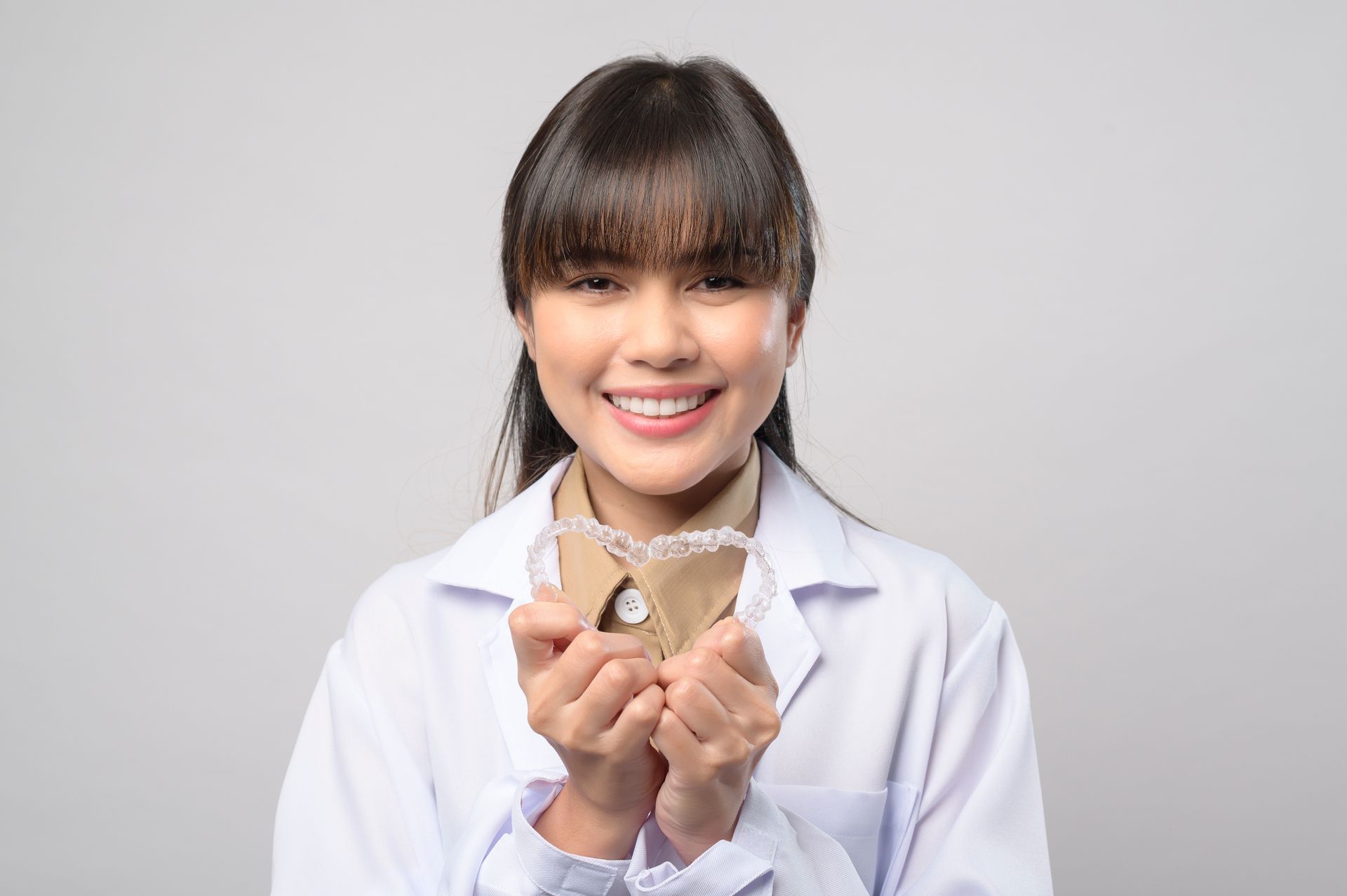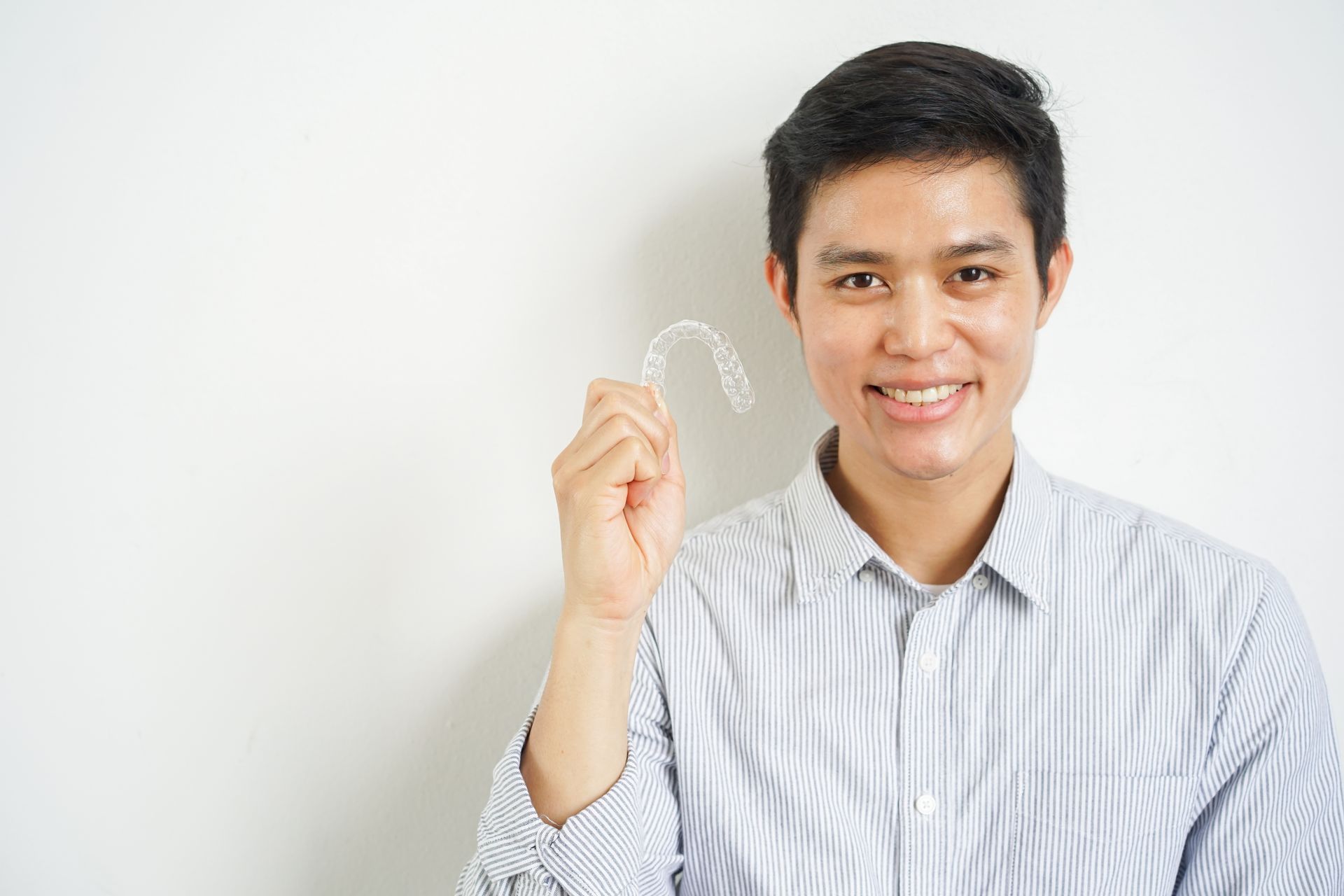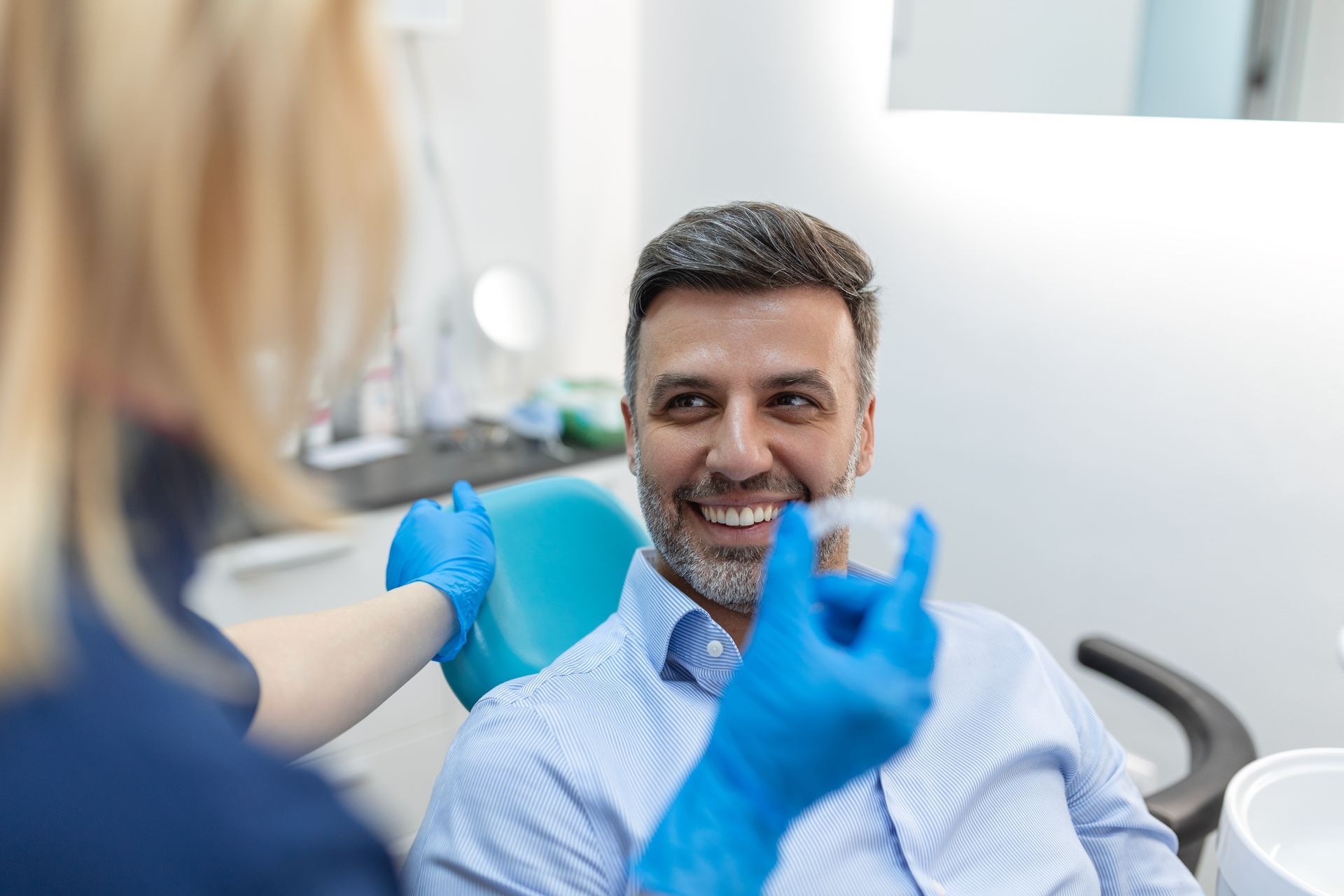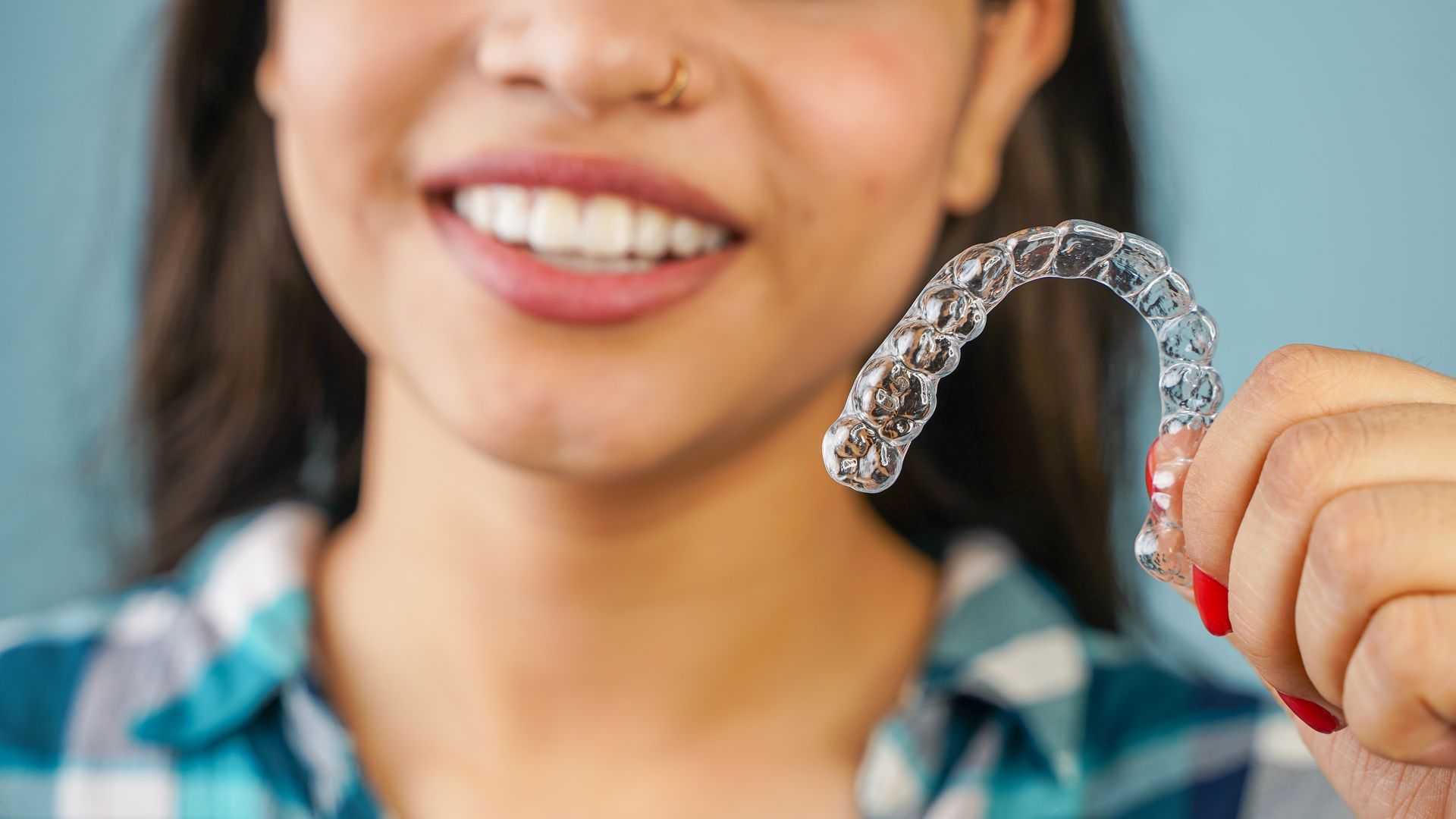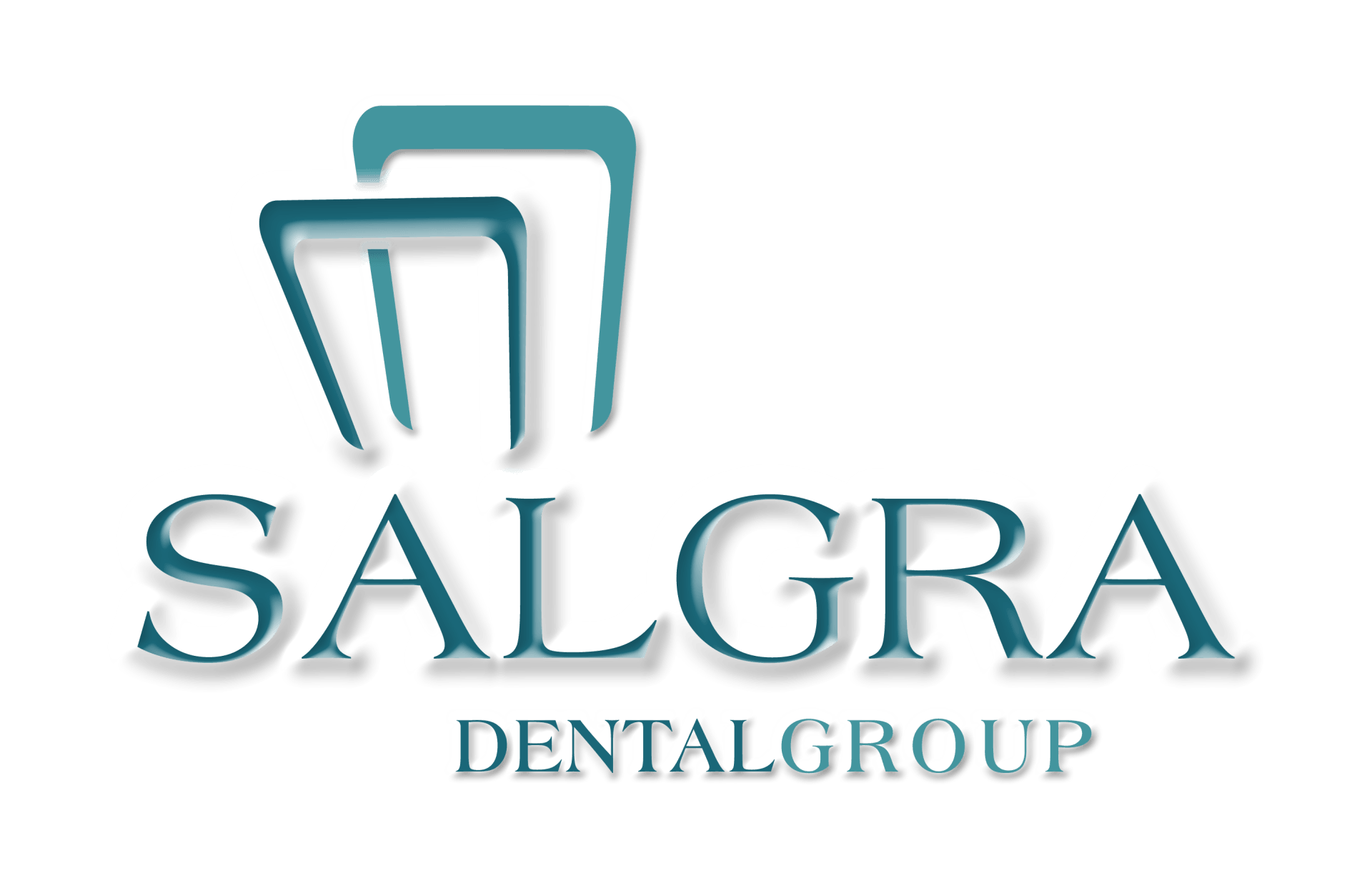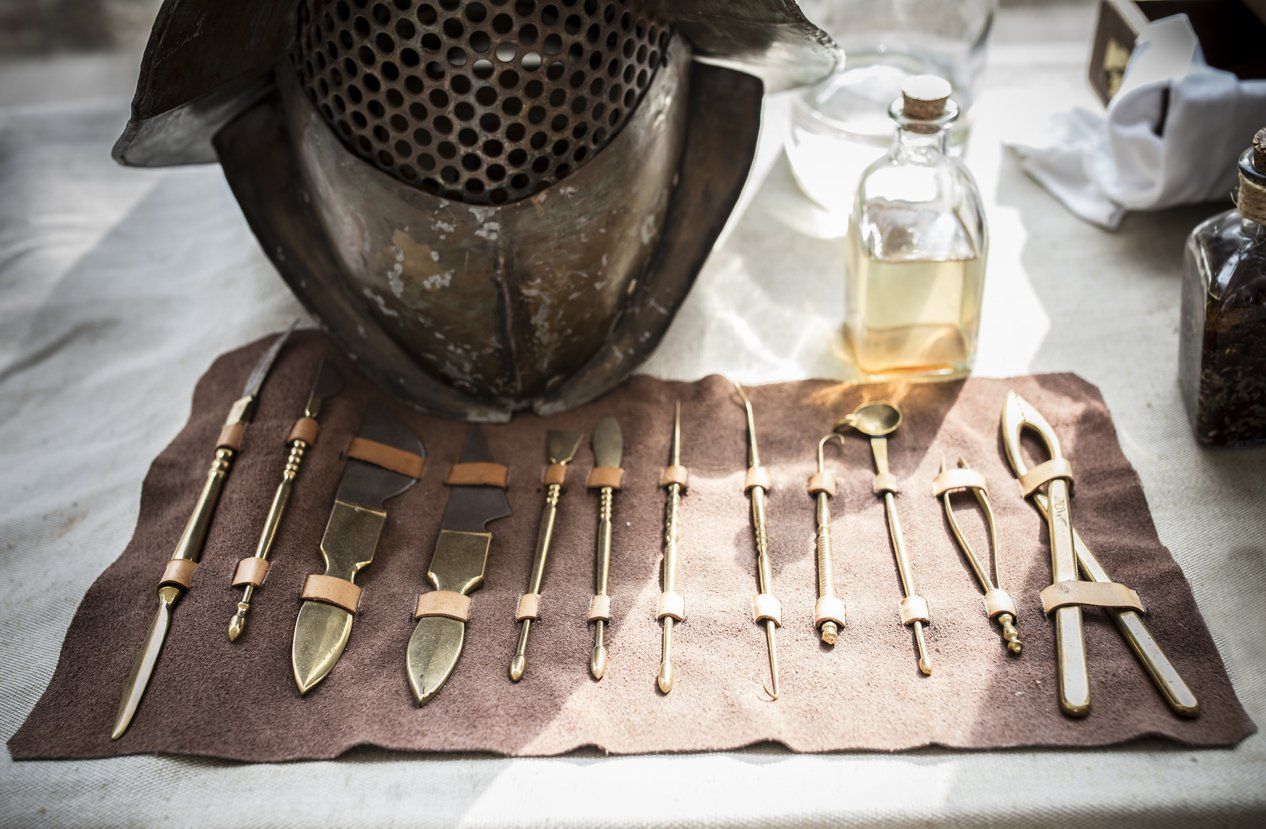By Salgra Dental
•
August 14, 2024
Are you tired of feeling self-conscious about your smile due to crooked or misaligned teeth? If so, you're not alone. Many people in Pembroke Pines, FL, struggle with teeth alignment issues, but did you know that a discreet and effective solution is available? Invisalign, a popular clear aligner, can transform your smile without the hassle of traditional metal braces. This guide explores why you should consider Invisalign for teeth straightening at Salgra Dental, and how it can revolutionize oral health and confidence. Key Takeaways: Here are the top reasons to consider Invisalign for teeth straightening at Salgra Dental: Discreet and Convenient: Invisalign offers a discreet and convenient way to straighten your teeth using clear aligners, making it an ideal option for those who want to avoid traditional metal braces. Customized Treatment: With Invisalign, you'll receive a customized treatment plan tailored to your specific dental needs, ensuring effective and efficient teeth straightening. Comfortable and Removable: Invisalign aligners are made of smooth, comfortable plastic and are removable, allowing you to eat, drink, and clean your teeth with ease. Professional Providers: In Pembroke Pines, FL, you can find experienced Invisalign providers, such as Claudia Salas, D.D.S in Salgra Dental, who can guide you through the treatment process. Improved Oral Health: By straightening your teeth with Invisalign, you can improve your overall oral health, reducing the risk of tooth decay, gum disease, and other dental problems Consider consulting with Dr. Claudia Salas, D.D.S in Salgra Dental to learn more about how this innovative teeth straightening solution can benefit your smile. Understanding Invisalign Before you consider Invisalign for teeth straightening in Pembroke Pines, FL, it's crucial to understand what it is and how it works. What is Invisalign? The Invisalign system is a revolutionary teeth-straightening solution that uses clear, removable aligners to move teeth into their desired position gently. These aligners are custom-made to fit your unique smile, making them virtually invisible and comfortable. How Does Invisalign Work? Invisalign can alleviate any concerns you may have about traditional metal braces. This innovative treatment uses a series of clear aligners that you wear for about one week each, gradually shifting your teeth into place. It's crucial to understand that each aligner is carefully crafted to apply gentle pressure to specific teeth, gradually moving them into their ideal position. As you progress through the series of aligners, your teeth will begin to shift, resulting in a straighter, more confident smile. With Invisalign, you'll be free to remove your aligners for oral hygiene, making it an ideal solution to maintain your daily routine. Types of Invisalign Treatments Invisalign offers a range of treatment options to cater to your unique needs and preferences. From comprehensive treatments to express solutions, Invisalign has got you covered. Here are the different types of Invisalign treatments available: Invisalign Full Invisalign Lite Invisalign Express Invisalign Teen Knowing which treatment is right for you can be overwhelming, but don't worry; we've got you covered. Here's a breakdown of each treatment option: Treatment Option Description Invisalign Full Comprehensive treatment for complex cases Invisalign Lite Moderate treatment for less complex cases Invisalign Express Express treatment for minor corrections Invisalign Teen Specialized treatment for teenagers Invisalign Full Invisalign Full is the most comprehensive treatment option for complex cases requiring significant corrections. This treatment is ideal for people with severely crooked teeth, gaps, or bite issues. Invisalign Lite Invisalign Lite is a moderate treatment option for less complex cases. This treatment is perfect for mildly crooked teeth or minor spacing issues. To get the most out of Invisalign Lite, you'll need to wear your aligners for at least 23 hours a day, just like with Invisalign Full. The main difference is that Invisalign Lite requires fewer aligners and a shorter treatment duration. Invisalign Express Treatments don't get any faster than Invisalign Express, designed for minor corrections that require only a few aligners. This treatment is ideal for people with very minor spacing issues or slightly crooked teeth. Understanding that time is of the essence, Invisalign Express can straighten your teeth in as little as three months. However, this treatment is unsuitable for everyone, so it's crucial to consult an Invisalign provider to determine whether you're a good candidate. Invisalign Teen An innovative solution for teenagers, Invisalign Teen, is designed for young patients who want to achieve a straighter smile without the hassle of traditional metal braces. A unique feature of Invisalign Teen is the "compliance indicator" that helps track wear time, ensuring your teenager stays on track with their treatment. Additionally, Invisalign Teen offers replacement aligners in case they get lost or damaged, giving you peace of mind. Factors to Consider for Invisalign in Pembroke Pines, FL To ensure you make an informed decision about Invisalign for teeth straightening in Pembroke Pines, FL, consider the following factors: Age and oral health Severity of teeth misalignment Budget and insurance coverage Lifestyle and personal preferences After evaluating these factors, you'll be better equipped to decide if Invisalign is the right choice for your teeth straightening needs in Pembroke Pines, FL. Age and Dental Alignment Health If you're considering Invisalign, your age and overall dental correction health play a significant role. While Invisalign can be effective for patients of all ages, it's important to consult with an experienced provider in Pembroke Pines, FL, like Claudia Salas, D.D.S , to determine if you're a suitable candidate. Severity of Teeth Misalignment Pembroke Pines residents with mild to moderate teeth misalignment can often benefit from Invisalign treatment. Invisalign is designed to correct a range of teeth misalignment issues, from minor spacing problems to more complex bite issues. With Invisalign, you can achieve a straighter, healthier smile without the need for metal brackets and wires. Budget and Insurance Coverage Many dental insurance plans cover a portion of the cost of Invisalign treatment. Be sure to check with your insurance provider to determine the extent of your coverage. The cost of Invisalign in Pembroke Pines, FL, varies depending on the complexity of your case and the experience of your Invisalign provider. At Salgra Dental, our team will work with you to develop a personalized treatment plan that fits your budget and meets your teeth straightening needs. Lifestyle and Personal Preferences Pembroke Pines residents with busy lifestyles may appreciate the convenience of Invisalign clear aligners. Since they're removable, you can eat, drink, and clean your teeth without any restrictions. Coverage is also an important aspect to consider. Suppose you're looking for a discreet teeth straightening solution. Invisalign's clear aligners are virtually invisible, making them ideal for those who want to maintain a professional or personal image during treatment. Step-by-Step Guide to Getting Invisalign Now that you've decided to consider Invisalign for teeth straightening in Pembroke Pines, FL, let's break down the process into manageable steps. Step Description 1. Scheduling a Virtual Consultation Initial consultation with an Invisalign provider in Pembroke Pines, FL 2. Creating a Personalized Treatment Plan Customized plan tailored to your specific teeth straightening needs 3. Receiving Customized Aligners Clear aligners designed specifically for your teeth and treatment plan 4. Wearing and Maintaining Aligners Ongoing care and maintenance to ensure successful treatment Scheduling a Virtual Consultation On your journey to a straighter smile, the first step is to schedule a virtual consultation with an Invisalign provider in Pembroke Pines, FL, such as Claudia Salas, D.D.S This initial meeting will help determine if Invisalign is right for you. Creating a Personalized Treatment Plan Getting a customized treatment plan is a crucial part of the Invisalign process. Your dentist will use advanced technology to create a 3D image of your teeth and design a personalized plan tailored to your needs. Understanding your treatment plan is necessary to achieve the desired results. Your dentist will explain the entire process, including the duration of treatment, the number of aligners you'll need, and any necessary adjustments. Receiving Customized Aligners There's no one-size-fits-all approach with Invisalign. You'll receive customized aligners designed specifically for your teeth and treatment plan. These clear aligners are made from BPA-free plastic and are virtually invisible. Another benefit of Invisalign is that the aligners are removable, allowing you to brush your teeth as usual. This makes the treatment process much more convenient than traditional metal braces. Wearing and Maintaining Aligners Personalized care is necessary to achieve successful results with Invisalign. To ensure the best possible outcome, you'll need to wear your aligners for at least 23 hours a day and maintain good oral hygiene habits. Aligners should be cleaned regularly to prevent bacterial buildup and odor. Your dentist will guide you on properly caring for your aligners and teeth during treatment. Tips for Successful Invisalign Treatment Keep in mind that successful Invisalign treatment requires commitment and dedication from you. To ensure the best results, follow these tips: Wearing aligners consistently Maintaining good oral hygiene Avoiding certain foods and drinks Attending regular check-ups Wearing Aligners Consistently One of the most critical factors in achieving successful Invisalign treatment is consistently wearing your aligners. You should wear your aligners for at least 23 hours daily, only removing them when brushing your teeth. Maintaining Good Oral Hygiene Tips for maintaining good oral hygiene during Invisalign treatment include: Brushing your teeth at least twice a day. Flossing once a day. Rinsing your mouth with mouthwash. This will help prevent tooth decay and gum disease. Still, it's crucial to maintain good oral hygiene habits to ensure the success of your treatment. Doing so lets you keep your teeth and gums healthy throughout the process. Avoiding Certain Foods and Drinks Foods that contain turmeric may stain your aligners and can damage your teeth. Avoid these types of foods or make sure to clean your teeth and aligners immediately after consumption. Understanding the importance of avoiding certain foods and drinks will help you make better choices during your Invisalign treatment. Doing so can prevent damage to your teeth and aligners, ensuring the best possible results. Attending Regular Check-Ups Regular check-ups with your Invisalign provider are crucial to monitor your treatment progress. During these appointments, your provider will assess the movement of your teeth and make any necessary adjustments to your treatment plan. Avoiding regular check-ups can lead to delays in your treatment, so it's important to prioritize these appointments. By doing so, you'll be able to stay on track and achieve the desired results from your Invisalign treatment. The key to successful Invisalign treatment is following these tips and committing to your treatment plan. By doing so, you'll achieve the beautiful, straight smile you've always wanted. Pros of Invisalign For those considering Invisalign for teeth straightening in Pembroke Pines, FL, it is necessary to weigh the advantages of this popular dental alignment solution. Pros •Convenience •Comfort •Discreetness •Easy oral hygiene •No food restrictions •Faster treatment time •Virtual preview of results •Removable aligners •Customized treatment plan Advantages: Convenience, Comfort, and Discreetness Individuals who value convenience, comfort, and discreetness will appreciate Invisalign's clear aligners. You can remove them to clean your teeth, making oral hygiene a breeze. The smooth, BPA-free plastic is gentle on your gums and cheeks, ensuring a comfortable fit. Plus, the nearly invisible aligners allow you to straighten your teeth without drawing attention to your dental work. Final Words Considering this, you now have a clear understanding of the top reasons why you should consider Invisalign for teeth straightening at Salgra Dental. With its discreet and convenient design, Invisalign offers a revolutionary approach to achieving a perfect smile. By choosing a reputable Invisalign provider in Pembroke Pines, such as Claudia Salas, D.D.S in Salgra Dental , you can trust that your teeth straightening journey will be in good hands. Take the first step towards a confident smile today! FAQ Q: What makes Invisalign a popular tooth-tightening choice at Salgra Dental? A: Invisalign is a popular choice for teeth straightening in Salgra Dental, because it offers a discreet and convenient way to achieve a straighter smile. The clear aligners are nearly invisible, making them a great option for those who want to avoid traditional metal braces. Additionally, Invisalign aligners are removable, allowing you to brush your teeth as you normally would. With Invisalign, you can achieve a straighter smile without sacrificing your lifestyle. Learn more about Invisalign treatment at Salgra Dental. Q: How does Invisalign compare to traditional metal braces regarding comfort and convenience? A: Invisalign is generally considered more comfortable and convenient than traditional metal braces. The clear aligners are custom-made to fit your teeth, reducing irritation and discomfort. They are also removable, allowing you to maintain your oral hygiene, whereas metal braces can be restrictive. Furthermore, Invisalign requires fewer office visits and no painful tightenings, making it a more convenient option for those with busy schedules. Discover the benefits of Invisalign over traditional metal braces. Q: Can Invisalign correct severe teeth alignment issues in Salgra Dental? A: Invisalign can correct a wide range of teeth alignment issues, from mild to severe. While it's true that Invisalign may not be suitable for every case, advancements in technology have made it possible to treat more complex cases than ever before. Our experienced Invisalign provider in Salgra Dental, Dr. Claudia Salas, D.D.S, can assess your teeth and determine if Invisalign is right for you. Schedule a consultation to discuss your teeth straightening options. Q: How long does Invisalign treatment typically take? A: The length of Invisalign treatment varies depending on the complexity of your case and your individual needs. On average, treatment can take anywhere from 6 to 18 months. However, with regular wear and proper care, you can see results in as little as 2-3 months. Our experienced Invisalign provider in Salgra Dental, will work with you to create a personalized treatment plan that fits your needs and goals. Learn more about the Invisalign process by scheduling a virtual consultation with Dr. Claudia Salas. Q: Is Invisalign more expensive than traditional metal braces at Salgra Dental? A: Our team at Salgra Dental can work with you to create a financing plan that fits your budget. Get a quote to start your invisalign treatment. Contact us NOW —------------------------------------------------------------------------------------------------------------- Dr. Claudia Salas, D.D.S Dr. Claudia Salas, D.D.S., is devoted to guiding her patients toward exceptional oral health. After graduating from New York University (NYU) College of Dentistry in 1995, s h e pursued further specialization with a Fellowship in Oral and Maxillofacial Surgery Dentistry in 1996. Currently, she is enhancing her skills at the esteemed LVI- Las Vegas Institute for Neuromuscular and esthetic Dentistry. With platinum plus status as an Invisalign provider, Dr. Salas excels in clear braces, offering precise alignment discreetly. Her accolades include recognition on the Honor Program Clinic at NYU and the Dean's List. Fluent in English and Spanish, Dr. Salas ensures personalized care and effective communication for all her patients. Dr. Tomasz Grabczak, D.D.S Dr. Tomasz Grabczak, D.D.S., is committed to delivering top-quality dental care in Broward County. A graduate of New York University (NYU) College of Dentistry with additional training in Oral and Maxillofacial Surgery Dentistry, he also attended the Medical Academy of Lublin, Poland. Dr. Grabczak's accolades include participation in NYU's Honor Program Clinic and Dean's List. Fluent in English and Polish, he ensures personalized care for his diverse patient base. Dr. Grabczak's mission is to provide the best dental care possible to the community of Broward County. Reach out to us by following our Google Maps location OR You can reach us by following our Google Driving directions
